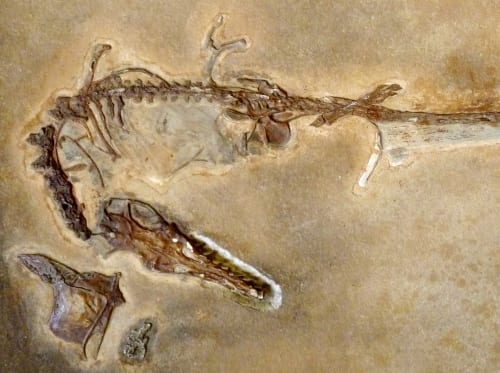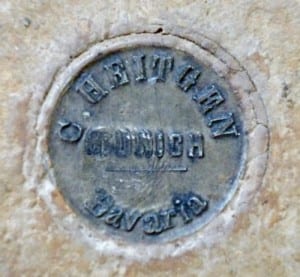Specimen of the Week 196 : A Real Fossil Pterosaur
By Tannis Davidson, on 13 July 2015
In my last post, I wrote about our ‘Zittel wing’ pterosaur cast and mentioned that I was doing a bit of research on another Grant Museum Rhamphorhynchus specimen. Pterosaurs were flying reptiles from the late Triassic to the end of the Cretaceous Period. They were the first vertebrates to evolve powered flight. While I admit to being biased toward our palaeontology collections, this second Rhamphorhynchus is a very special specimen – definitely one of the unsung highlights of the Museum. It’s rare, has a fascinating (if enigmatic) history and is a wonderful example of positive re-identification. Why it hasn’t been given the full SOTW treatment I. Just. Don’t. Know. Without further ado, this week’s Specimen of the Week is…
**The Rhamphorhynchus muensteri fossil**
1. You’re just too good and you’re true, can’t keep my eyes off you
A few years ago, when one of the pterosaur casts was lifted up, it turned out to be suspiciously heavy. It had always been assumed that it was a plaster cast of one of the 100 or so Rhamphorhynchus specimens that have been found in the fossil record. Further inspection revealed manganese deposits on the back of the limestone slab as well as two coprolites and what apppears to be an ammonite mouth-part embedded in the matrix – all indicating that this was a fossil and not a plaster cast replica.
2. Pardon the way that I stare, there are only two* to compare
There is a cast of the Grant Museum’s R. muensteri fossil LDUCZ-X1093 in the Manchester Museum at the University of Manchester and another at the Museo Geologico Giovanni Capellini in Bologna, Italy. According to David Gelsthorpe, Curator of Paleontology at the Manchester Museum, their cast was most likely purchased with another pterosaur cast which appears on their register in 1891 (1). Unfortunately, our own records of this specimen are very limited – it was retrospectively accessioned in 2009 as being from Eichstatt, Bavaria – but there is no detail regarding when it first came into the Grant Museum.
3. You’d feel like heaven to touch, I wanna hold you so much
One of the first people to view and work on this specimen was Carl (Karl) Heitgen. The fossil bears his preparator’s mark – a small circular seal fixed into the limestone reading “C. HEITGEN MUNICH Bavaria”. Heitgen was the preparator in the Palaeontology Collection at Ludwig-Maximilians-University Munich from at least 1864 – 1891/92 (the first and last times he is listed on the staff directory). At the university during these years he worked with two of the greats of palaeontology: Albert Oppel and Karl Alfred von Zittel. These were exciting times – Charles Darwin had just published his theory of evolution in 1859 and many new exquisitely preserved fossils were being discovered in the nearby quarries of Solnhofen and Eichstatt such as the the first Archaeopteryx specimens and numerous pterosaurs including the celebrated Rhamphorhynchus “Zittel wing”.
Interestingly, Heitgen is mentioned in the 1886 Royal College of Surgeons’ Annual Report of the Conservator to the Museum Committee whereby a series of models of Pterosauria “made by C. Heitgen of Munich” are given top billing in a list of ” the most noteworthy additions to the Collection during the year” (2). Named facsimile models are Compsognathus longipes, Pterodactylus tcochi, Pterodactylus scolopaciceps, Pterodactylus longirostris, and Rhamphorhynchus münsteri (2 head, 1 pelvis and tail, 1 forelimb, 1 entire body) (3). Unfortunately, these models and any associated documentation were lost in 1941 when the RCS was bombed during the war (4).
4. At long last love has arrived, but sadly I’m no longer alive
The Grant Museum’s Rhamphorhynchus specimen died during the Upper Jurassic Period around 152 million years ago. The skull length (105.8 mm) places it in the larger size range for Rhamphorhynchus (lengths of the skulls ranging from 21 mm – 191.5 mm) (5). S. Christopher Bennett’s (1995) statistical and morphological study of Rhamphorhynchus argued that size variation amongst specimens are related to ontogeny indicating three size categories – juvenile, subadults and adult (6). This would place our specimen as an adult. However, microscopic analysis of Rhamphorhynchus bones by Prondvai et. al. (2012) has shown that within Bennett’s same size categories there are individuals of various ages and therefore Bennett’s formula cannot be used as an indicator of real ontogenetic stage (7).
However, this specimen can still tell us a lot. As such, it is regularly used in teaching at UCL – in various biology and geology classes focussing on turning points of vertebrate evolution. Although incomplete, it is a well-preserved fossil which shows distinctive Rhamphorhynchoid features including the long vertebral tail, stiffened by rod-like ossified ‘tendons’, characteristic skull shape and its forward-inclined teeth set in individual sockets.
Tannis Davidson is Curatorial Assistant at the Grant Museum of Zoology
* Perhaps you have seen a cast of the Grant Museum specimen in another collection…please let us know.
References
1. Personal correspondence between Jack Ashby, Manager, Grant Museum of Zoology and David Gelsthorpe, Curator of Palaeontology, Manchester Museum, University of Manchester, Oxford Road, Manchester.
2. [online] http://www.mocavo.co.uk/Calendar-of-the-Royal-College-of-Surgeons-of-England-1886/897567/370#370 (accessed 07/07/2015)
3. [online] http://www.mocavo.com/Calendar-of-the-Royal-College-of-Surgeons-of-England-1886/897567/370#380 (accessed 07/07/2015)
4. Personal correspondence with Sarah Pearson, Curator, Hunterian Museum, Royal College of Surgeons of England, London.
5. Wellnhofer, P., 1975. Die Rhamphorhynchoidea (Pterosauria) der Oberjura-Plattenkalke Suddeutschlands. Palaeontoographica (A), 149:1-30; Stuttgart.
6. Bennett, S.C. 1995. “A Statistical Study of Rhamphorhynchus from the Solnhofen Limestone of Germany: Year-Classes of a Single Large Species”. Journal of Paleontology, Vol. 69. No.3 (May 1995), pp. 569-580
7. Prondvai, E., Stein, K., Osi, A., Sande, M.P. 2012. “Life History of Rhamphorhynchus Inferred from Bone Histology and the Diversity of Pterosaurian Growth Strategies”.[online] http://journals.plos.org/plosone/article?id=10.1371/journal.pone.0031392 (accessed 07/07/2015)
3 Responses to “Specimen of the Week 196 : A Real Fossil Pterosaur”
- 1
-
2
Underwhelming Fossil Fish of the Month: January 2016 | UCL Museums & Collections Blog wrote on 29 January 2016:

[…] of this specimen is unknown but from the preservation and the covered up preparator’s mark (possibly the same mark as this Grant Museum Rhamphorhynchus fossil) this specimen could be from the Solnhofen limestone, a Lagerstätte site, where exceptionally […]
-
3
Specimen of the Week 226: Preserved neonatal rat group | UCL Museums & Collections Blog wrote on 8 February 2016:

[…] deer antlers), ‘half cat’ (the dorsal-ventrally bisected pregnant cat), ‘Rinki’ (the Rhamphorhynchus fossil), ‘Flatypus’ and ‘Platysausage’ (the bad-taxidermied platypuses) and the lord of the […]
 Close
Close






[…] findings to emerge as I continue with my GMZ-Rhamphorhynchus-research-junket. Tune in for my next SOTW post to learn […]